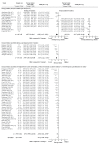Ageing Is Associated with Decreases in Appetite and Energy Intake--A Meta-Analysis in Healthy Adults
- PMID: 26751475
- PMCID: PMC4728642
- DOI: 10.3390/nu8010028
Ageing Is Associated with Decreases in Appetite and Energy Intake--A Meta-Analysis in Healthy Adults
Abstract
It is not well recognized that in the elderly weight loss is more common than weight gain. The aim of this analysis was to determine the effect of ageing on appetite (hunger/fullness) and energy intake, after overnight fasting and in a postprandial state, by meta-analyses of trials that included at least two age groups (>18 years). We hypothesized that appetite and energy intake would be less in healthy older compared with younger adults. Following a PubMed-database systematic search up to 30 June 2015, 59 studies were included in the random-effects-model meta-analyses. Energy intake was 16%-20% lower in older (n = 3574/~70 years/~71 kg/~25 kg/m²) than younger (n = 4111/~26 years/~69 kg/~23 kg/m²) adults (standardized mean difference: -0.77 (95% confidence interval -0.90 to -0.64)). Hunger was 25% (after overnight fasting; weighted mean difference (WMD): -17 (-22 to -13) mm) to 39% (in a postprandial state; WMD: -14 (-19 to -9) mm) lower, and fullness 37% (after overnight fasting; WMD: 6 mm (95% CI: 1 to 11 mm)) greater in older than younger adults. In conclusion, appetite and energy intake are less in healthy older than younger adults, suggesting that ageing per se affects food intake.
Keywords: ageing; appetite; elderly; energy intake; fullness; hunger.
Figures



References
-
- Australian Institute of Health and Welfare (AIHW) Australia's Health. AIHW; Canberra, Australia: 2014. (Ausrtalia’s Health Series No. 14. Cat. No. AUS 178).
-
- Briefel R.R., McDowell M.A., Alaimo K., Caughman C.R., Bischof A.L., Carroll M.D., Johnson C.L. Total energy intake of the us population: The third national health and nutrition examination survey, 1988–1991. Am. J. Clin. Nutr. 1995;62:1072S–1080S. - PubMed
Publication types
MeSH terms
LinkOut - more resources
Full Text Sources
Other Literature Sources
Medical

